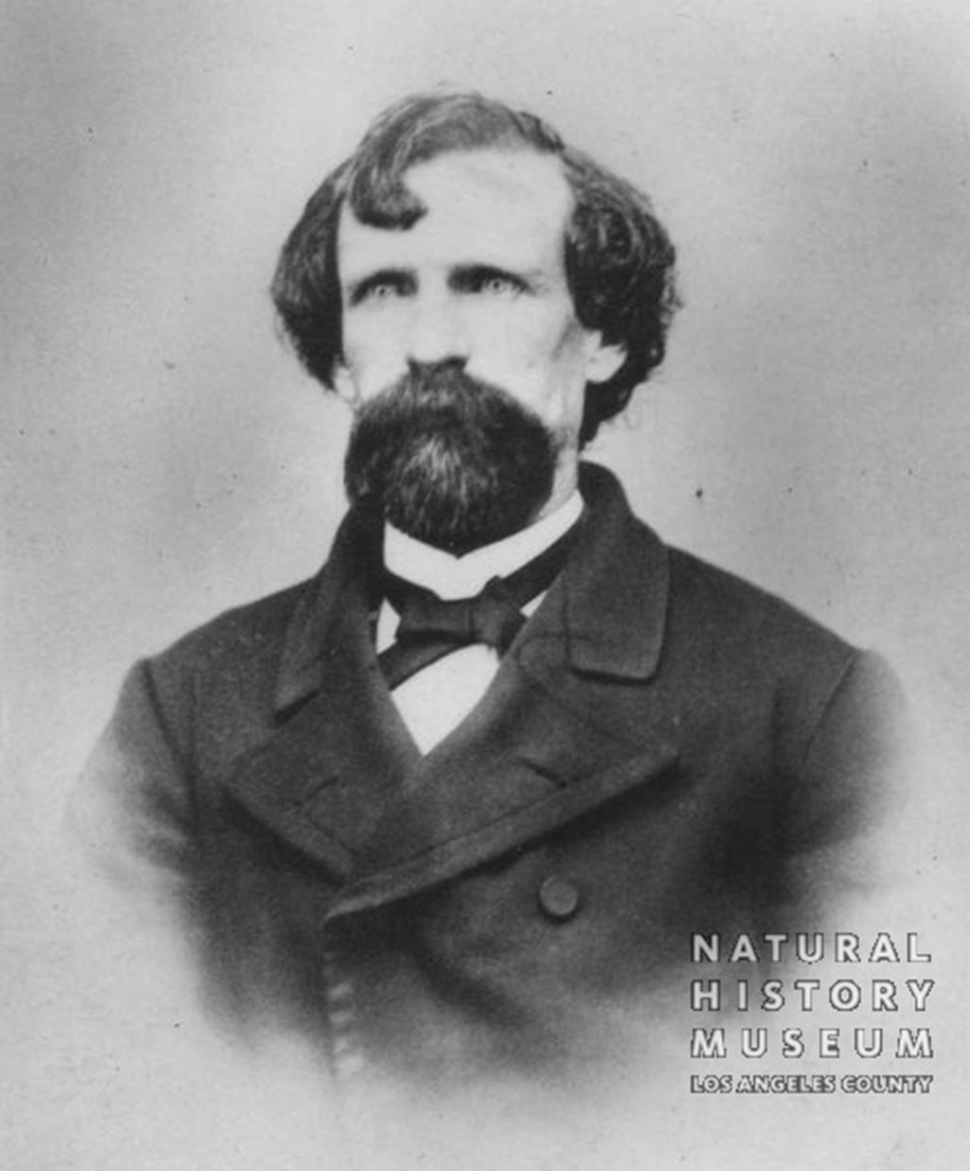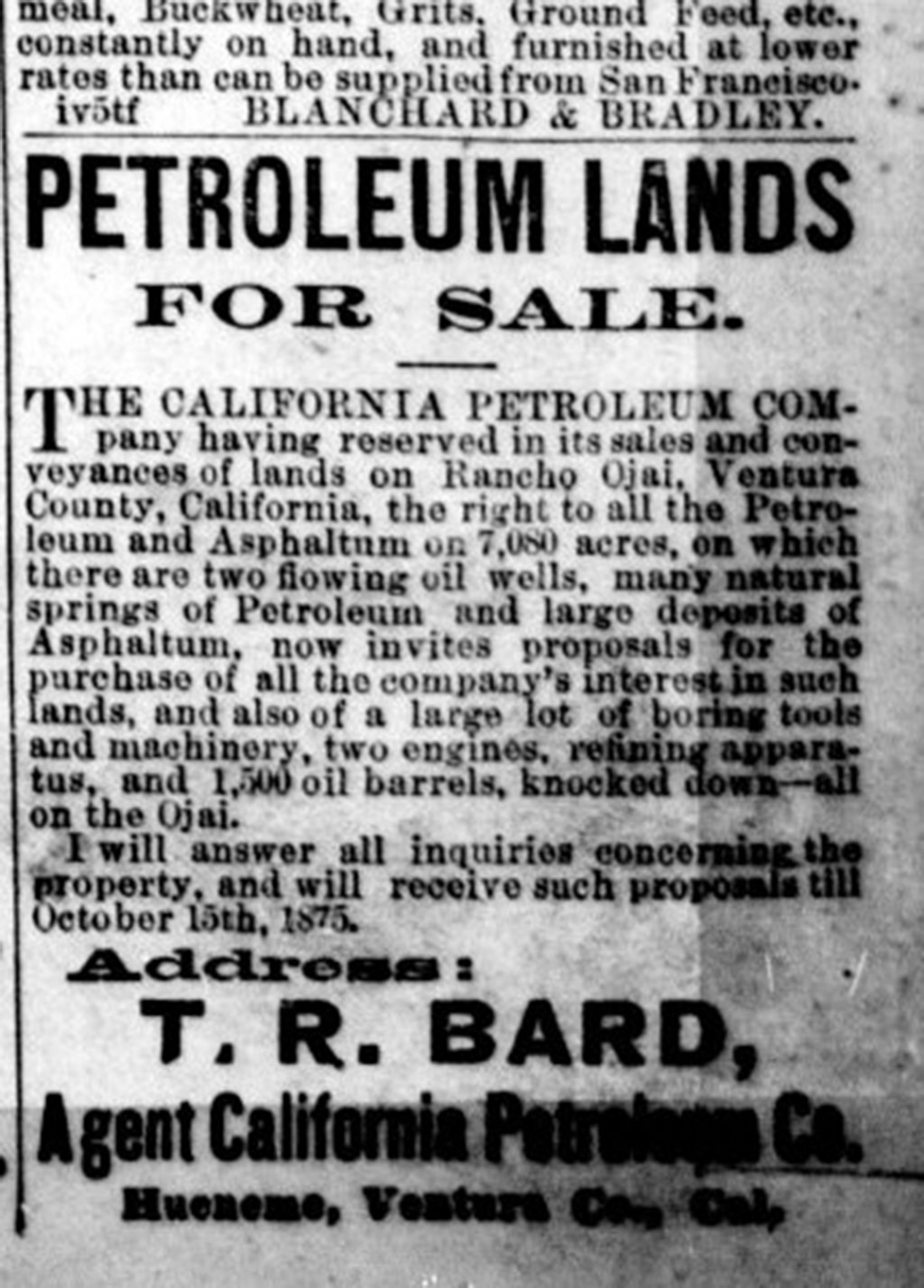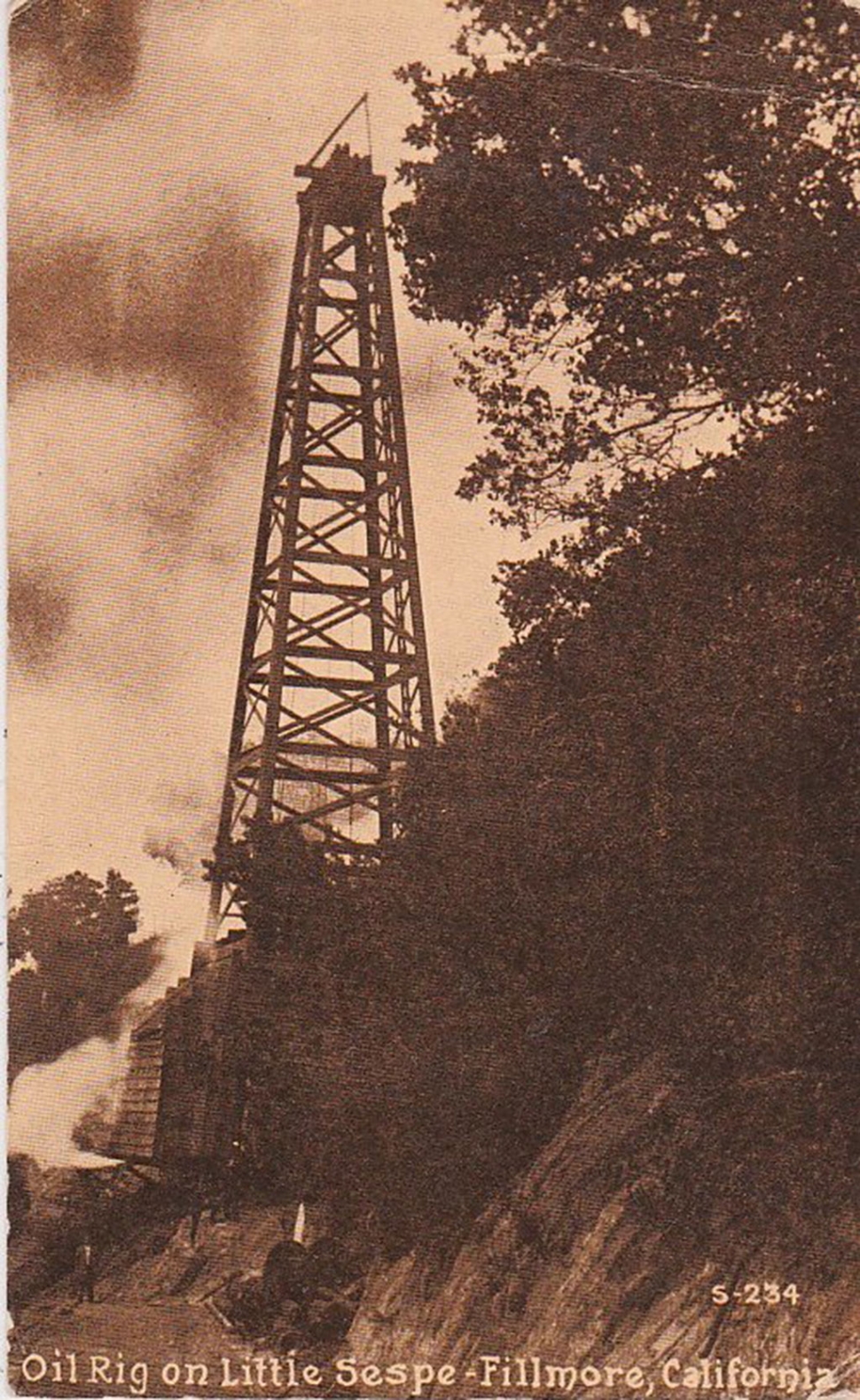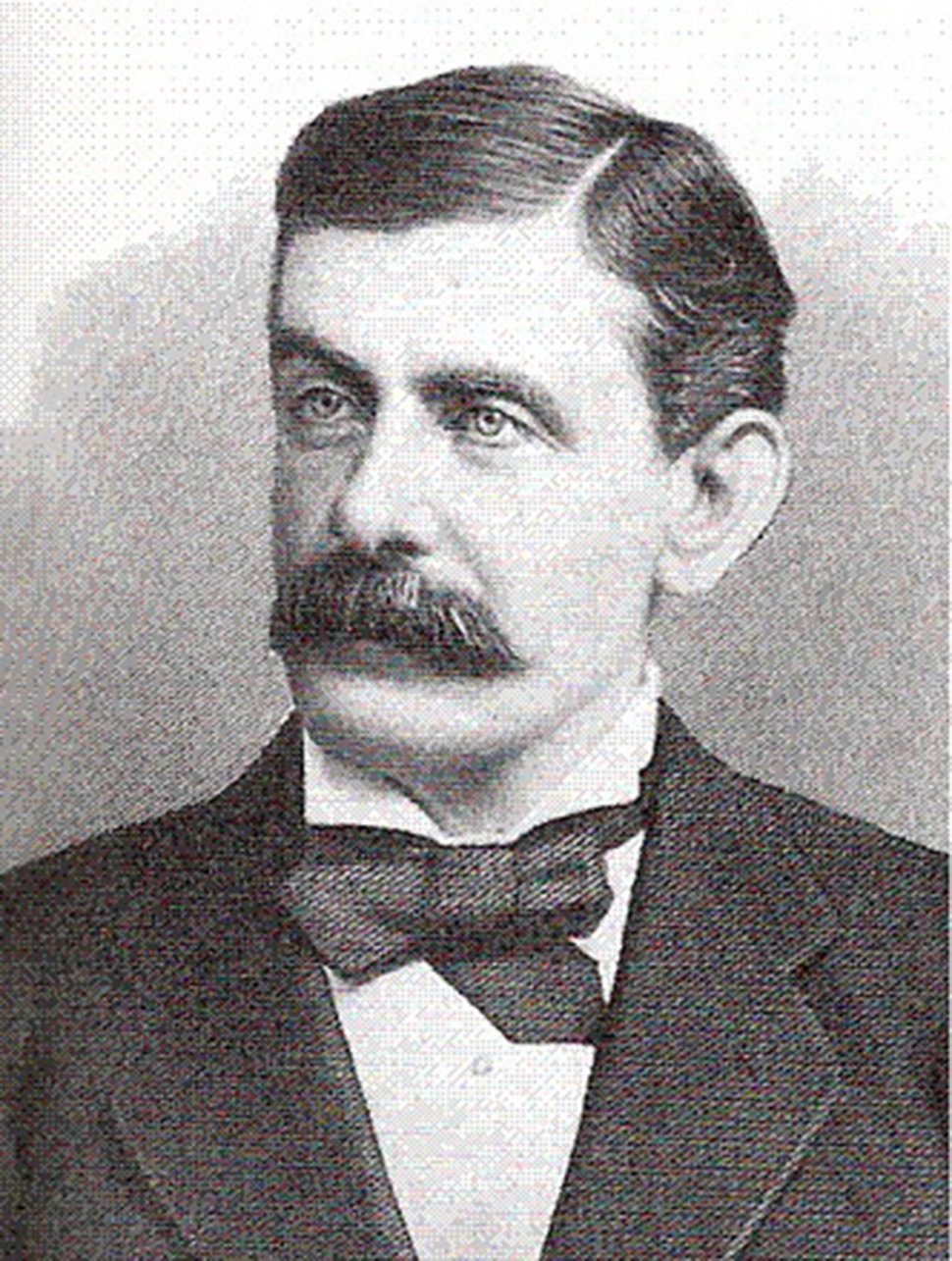|
Fillmore Historical Museum Brings You: The Story of Joe Dye and Oil - Part 1
 Joe Dye, circa 1870. Photos Courtesy Natural Historical Museum of Los Angeles. By Anonymous — Wednesday, June 10th, 2020
 Ventura Signal Volume V Number 24, 2 October 1875.   Thomas Robert Bard Courtesy Fillmore Historical Museum If you have been reading the last few stories from the Fillmore Historical Museum, you will have noticed that names keep recurring. This article will be no different. This shouldn’t be surprising since in the 1870’s and early 1880’s there were only a few hundred people in the Sespe/Cienega area (Fillmore didn’t yet exist). They were neighbors and business partners. They might be friends one month and bitter enemies the next, usually because of water or mineral rights. Most sources agree that it was Thomas Bard who brought in the first successful drilled well on Thomas Scott’s property in Ojai in 1867. He was sent to this area as a representative of Scott, acting Assistant Secretary of War under President Lincoln, and who was also president of the Pennsylvania Railroad. Mr. Scott had approximately 350,000 acres in California at that time. Bard would continue to act as Mr. Scott and/or Pennsylvania Railroad’s agent for many years. The Ventura County Signal, October 2, 1875, included an advertisement offering for sale the California Petroleum Company’s (owned by the Pennsylvania Railroad) interest in 7,080 acres of Rancho Ojai “on which there are two flowing oil wells, many natural springs of Petroleum and large deposits of Asphaltum.” The agent for the California Petroleum Company was T. R. Bard of Hueneme. With the growing need for oil many people came to the area looking for petroleum. One of the folks it attracted was Joseph Franklin Dye. Joe Dye, born in 1831, was originally from Kentucky but had moved to Texas with his family (he was one of sixteen children) in the 1840s. He and two of his brothers went west to the California gold fields, but returned empty handed. He then headed to New Mexico and Arizona where he apparently worked as a miner and teamster. Besides being a wanderer, Joe also soon became known for having a short temper and a hair trigger. In the early 1850s, he got into a dispute in New Mexico with ”Hand Saw” Pete Fantig (who apparently got the nickname because he killed a man by cutting him into pieces with a handsaw) over a card game. This ended with Joe shooting Hand Saw in the neck. Hand Saw survived to be later shot by a gambler in Salt Lake City. A Southern sympathizer, Dye has also been identified as one of the men who rode with the Confederate guerilla group in Southern California headed by John Mason and Jim Henry. By the time Joe Dye came to the Santa Clara River Valley in the early 1870s, Dye had killed or wounded several men both while serving as a law officer in Los Angeles and while a private citizen. In October 1870 he shot and killed Los Angeles City Marshal William Warren over reward money, but was acquitted. In the July 4, 1874, Ventura Signal, an announcement was published of the creation of the Piru Mining Company, a partnership made up of Joseph Dye, S. Levy and Charles Holmes all of Los Angeles. The mining partnership only lasted a couple of years, but Dye became familiar with the area north of the Santa Clara River. He filed claims in the Alamo Mountain and Little Sespe areas. By May, 1875, the same paper announced that “Somewhere in the Alamo mountains, Mr. Joe Dye has discovered a flow of fine petroleum, almost pure; so pure that it can be put into a lamp and burned, without refining.” Dye lost little time developing his claim, which brought him into conflict with anyone else filing claims in the same area. By 1878, Dye was elected chairman of the Little Sespe Petroleum District which was to “bring order” to the claims in the area and oppose any take over by “tenderfeet from Los Angeles”. The District required that to keep a claim, the claimant had to spend at least $200 improving the property and it must have clearly established boundaries. In August, 1884, J. F. Dye, “incorporator of the district” and J. C. Udall “recorder of the district” wrote a letter in the Los Angeles Herald making it clear that the Sespe was not controlled by the Los Angeles capitalists, although they had leased 800 acres from one of the undersigned, undoubtedly Dye. Instead it is the members of the district who controlled the bulk of the resources. About this time, Dye married and lived in the Sespe with his wife, Francesca (or in another account, Grace), and their daughter, Grace (according to one later newspaper account there was also a baby boy). Things seemed to be going well for Joe Dye. Including all of his mining claims, his net worth was thought to be at this time close to $200,000. He took on a partner, H. J. Crow of Glendale, and hired a local man, Herman Haines, formerly postmaster at Cienega, as help on his claim. By the fall of 1886, however, Dye was in jail for the murder of Herman Haines. Dye had discovered that his young bride (she was at least 20 years younger than he) was romantically involved with his partner, H. J. Crow, and that Haines and his son acted as intermediaries between the two. Dye confronted his wife and sent her home to her parents. He then fired Haines telling him to keep away from him. Haines took to carrying a Henry rifle with him telling people it was for Joe Dye. For whatever reason, both men found themselves in Morris Cohn’s store/saloon in Santa Paula. Most accounts agree that Haines went for his rifle first but Dye was the better shot and shot longer. The wounded Haines ran out onto Main Street with Dye still shooting. Haines fell in the middle of the street, dying several days later. Dye gave himself up to authorities and was released on $10,000 bail. When he came to trial he was represented by Stephen M. White and Henry T. Gage, later Governor of California, both with known ties to the petroleum industry. Dye was initially convicted and sentenced to 16 years, but a new trial was granted and in November of 1888 he was acquitted, but only after spending fourteen months in jail. [To be continued] |
